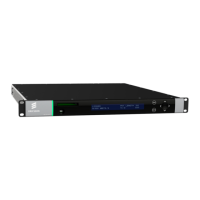Using the Equipment
3.10.5.5 Functional Description
The IP Input Card supports the following feature set:
• ProMPEG FEC
• Two RJ-45 interfaces and PHY which meet the Ethernet electrical specifications
as defined in IEEE 802.3 100/1000BaseT Ethernet, Full Duplex mode.
• MDI statistic – Delay Factor and Media Loss Rate.
• SNMPv1 (MIB-II and MDI values in read-only mode).
• CBR MPTS/SPTS feeds.
• Support a maximum TS Rate of 216 Mbps.
• Support configurable IP de-jittering buffer level up to 60 ms
• 1-7 TS packet per IP frame
• IGMP v2/v3
• VLAN ID support
The mapping of MPEG-2 TS packets into IP data frames is done according to the
protocol stack shown below. The figure shows the Protocol Stack in use when
mapping MPEG-2 into IP frames and Ethernet.
Figure 3.46 The Protocol Stack
The MPEG-2/DVB layer is specified in ISO/IEC IS 13818 – Generic Coding of
Moving Pictures and Associated Audio. The UDP layer is compliant with RFC768 –
User Datagram Protocol. A configurable number of 188 byte MPEG-2 TS packets
are mapped straight into an UDP frame with no additional overhead. The MTU for
Ethernet is usually 1500 bytes. This limits the number of MPEG-2 TS packets per
UDP frame to lie within one to seven.
Link layer – 1000BaseT Ethernet
Transport layer - IP
UDP – User Datagram Protocol
MPEG-2/DVB layer
Control traffic for in-
band management
(telnet, http, snmp)
(Multi-Program Transport
Stream or Single-Program
Transport Stream)

